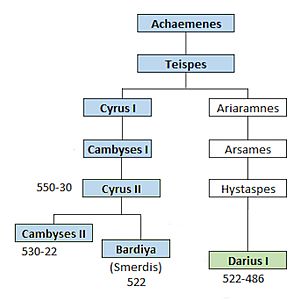Teispes facts for kids
Quick facts for kids Teispes |
|
|---|---|
| Great King King of Anshan |
|

Position of Teispes in the Achaemenid lineage according to Darius the Great in the Behistun inscription.
|
|
| King of Persia | |
| Reign | 675–640 BC |
| Predecessor | Achaemenes |
| Successor | Cyrus I |
| Died | 640 BC |
| Issue |
|
| House | Achaemenid |
| Father | Achaemenes |
Teispes was an important ruler of Anshan from 675 to 640 BC. He was the son of Achaemenes, who founded the Achaemenid royal family. Teispes is known as an ancestor of two very famous Persian kings: Cyrus the Great and Darius the Great.
Historians believe that Teispes had two sons: Cyrus I and Ariaramnes. Cyrus I was the grandfather of Cyrus the Great. Ariaramnes was the great-grandfather of Darius the Great.
During his rule, Teispes captured the city of Anshan from the Elamite people. This likely happened after the Persians became free from the control of the Medes. Teispes then expanded his small kingdom. However, his kingdom was still under the control of the powerful Neo-Assyrian Empire at that time. After Teispes, his son Cyrus I became the next ruler.
Who Was Teispes?
Teispes was a king of Anshan, a region in ancient Persia. He ruled for 35 years, from 675 BC to 640 BC. His father was Achaemenes, who started the Achaemenid dynasty. This family would later become very powerful.
Teispes helped to make his kingdom bigger. He took control of Anshan, which was an important city. Even though his kingdom grew, it was still part of the Neo-Assyrian Empire. This means he had to follow the rules of the Assyrian king.
Teispes' Family and Legacy
Teispes is a key figure in the history of the Achaemenid Empire. He connects the early rulers to the later, more famous kings. His son, Cyrus I, continued his rule. Cyrus I's grandson was Cyrus the Great, who built a huge empire.
Teispes' other son, Ariaramnes, also had important descendants. His great-grandson was Darius the Great. Darius was another very powerful Achaemenid king. This shows how important Teispes was to the royal family tree.
See also
 In Spanish: Teispes para niños
In Spanish: Teispes para niños
- Teispid

